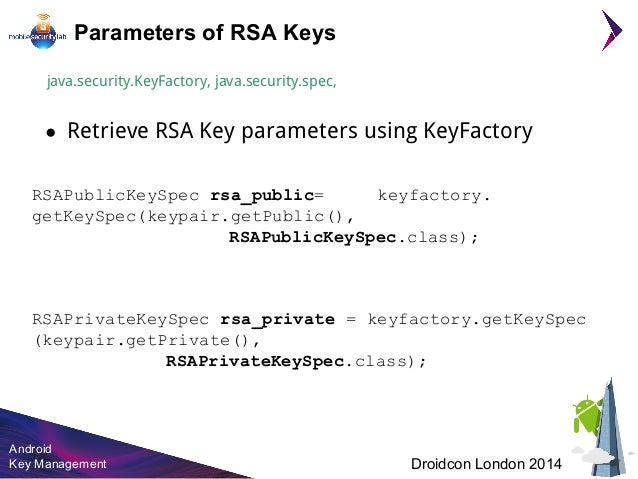Rsa Key Pair Generator In Java
This chapter demonstrates how to generate an RSA based OpenPGP key pair with OpenPGP Library for Java. When we create an OpenPGP key pair, a few parameters must be passed. These include: Encryption key size in bytes (recommended between 1024 and 3072) User ID key algorithm (RSA or ELGAMAL) private key password list of preferred.
Contents
- 3. Saving the Keys in Binary Format
- Source Code
- The next step is to initialize the key pair generator. All key pair generators share the concepts of a keysize and a source of randomness. The KeyPairGenerator class has an initialize method that takes these two types of arguments. The keysize for a DSA key generator is the key length (in bits), which you will set to 1024.
- JAVA generate RSA Public and Private Key Pairs using bouncy castle Crypto APIs The following sample code generates RSA public and private keys and save them in separate files. You can pass the file names as input parameters and the program generates keys with 1024-bit size.
- Bouncy Castle Java Distribution (Mirror). Contribute to bcgit/bc-java development by creating an account on GitHub.
- Usage Guide - RSA Encryption and Decryption Online. In the first section of this tool, you can generate public or private keys. To do so, select the RSA key size among 515, 1024, 2048 and 4096 bit click on the button.
- Online RSA Key Generator. Key Size 1024 bit. 512 bit; 1024 bit; 2048 bit; 4096 bit Generate New Keys Async. RSA Encryption Test.
1. Introduction
Let us learn the basics of generating and using RSA keys in Java.
Java provides classes for the generation of RSA public and private key pairs with the package java.security. You can use RSA keys pairs in public key cryptography. Audiosurf 2 mac download free.
Public key cryptography uses a pair of keys for encryption. Distribute the public key to whoever needs it but safely secure the private key.
Public key cryptography can be used in two modes:
Encryption: Only the private key can decrypt the data encrypted with the public key.
Authentication: Data encrypted with the private key can only be decrypted with the public key thus proving who the data came from.
2. Generating a Key Pair
First step in creating an RSA Key Pair is to create a KeyPairGeneratorfrom a factory method by specifying the algorithm (“RSA” in this instance):
Initialize the KeyPairGenerator with the key size. Use a key size of 1024 or 2048. Currently recommended key size for SSL certificates used in e-commerce is 2048 so that is what we use here.
From the KeyPair object, get the public key using getPublic() and the private key using getPrivate().
3. Saving the Keys in Binary Format
Save the keys to hard disk once they are obtained. This allows re-using the keys for encryption, decryption and authentication.

What is the format of the saved files? The key information is encoded in different formats for different types of keys. Here is how you can find what format the key was saved in. On my machine, the private key was saved in PKCS#8 format and the public key in X.509 format. We need this information below to load the keys.
3.1. Load Private Key from File
After saving the private key to a file (or a database), you might need to load it at a later time. You can do that using the following code. Note that you need to know what format the data was saved in: PKCS#8 in our case.
3.2 Load Public Key from File
Load the public key from a file as follows. The public key has been saved in X.509 format so we use the X509EncodedKeySpec class to convert it.
4. Use Base64 for Saving Keys as Text
Save the keys in text format by encoding the data in Base64. Java 8 provides a Base64 class which can be used for the purpose. Save the private key with a comment as follows:
Online Rsa Key Generator
And the public key too (with a comment):
5. Generating a Digital Signature
As mentioned above, one of the purposes of public key cryptography is digital signature i.e. you generate a digital signature from a file contents, sign it with your private key and send the signature along with the file. The recipient can then use your public key to verify that the signature matches the file contents.
Here is how you can do it. Use the signature algorithm “SHA256withRSA” which is guaranteed to be supported on all JVMs. Use the private key (either generated or load from file as shown above) to initialize the Signatureobject for signing. It is then updated with contents from the data file and the signature is generated and written to the output file. This output file contains the digital signature and must be sent to the recipient for verification.
6. Verifying the Digital Signature
The recipient uses the digital signature sent with a data file to verify that the data file has not been tampered with. It requires access to the sender’s public key and can be loaded from a file if necessary as presented above.

The code below updates the Signature object with data from the data file. It then loads the signature from file and uses Signature.verify() to check if the signature is valid.
And that in a nutshell is how you can use RSA public and private keys for digital signature and verification.
Source Code
Rsa Key Pair
Go here for the source code.